Comparative Analysis: DXA Scanning Techniques for Cerebral Palsy
VerifiedAdded on 2020/11/12
|14
|3687
|357
Report
AI Summary
This report provides a comprehensive overview of Cerebral Palsy (CP), its definition, classification, epidemiology, and the difficulties faced by individuals with CP. It highlights the impact of CP on physical and mental health, including musculoskeletal and neuromuscular impairments. The report emphasizes the importance of DXA scanning in diagnosing bone loss in CP children, detailing the clinical relevance of DXA and various immobilization techniques used during scanning procedures. These techniques include spinal immobilization, whole-body wrapping (swaddling), vacuum splint devices, compression bandages, Pigg-O-Stat immobilization units, and Papoose boards. Each technique is described with its objectives, benefits, and limitations, addressing the challenges faced by technicians and radiologists during patient mobilization. The report aims to inform healthcare professionals about the efficacy of different methods to improve the quality of DXA scans and patient outcomes.
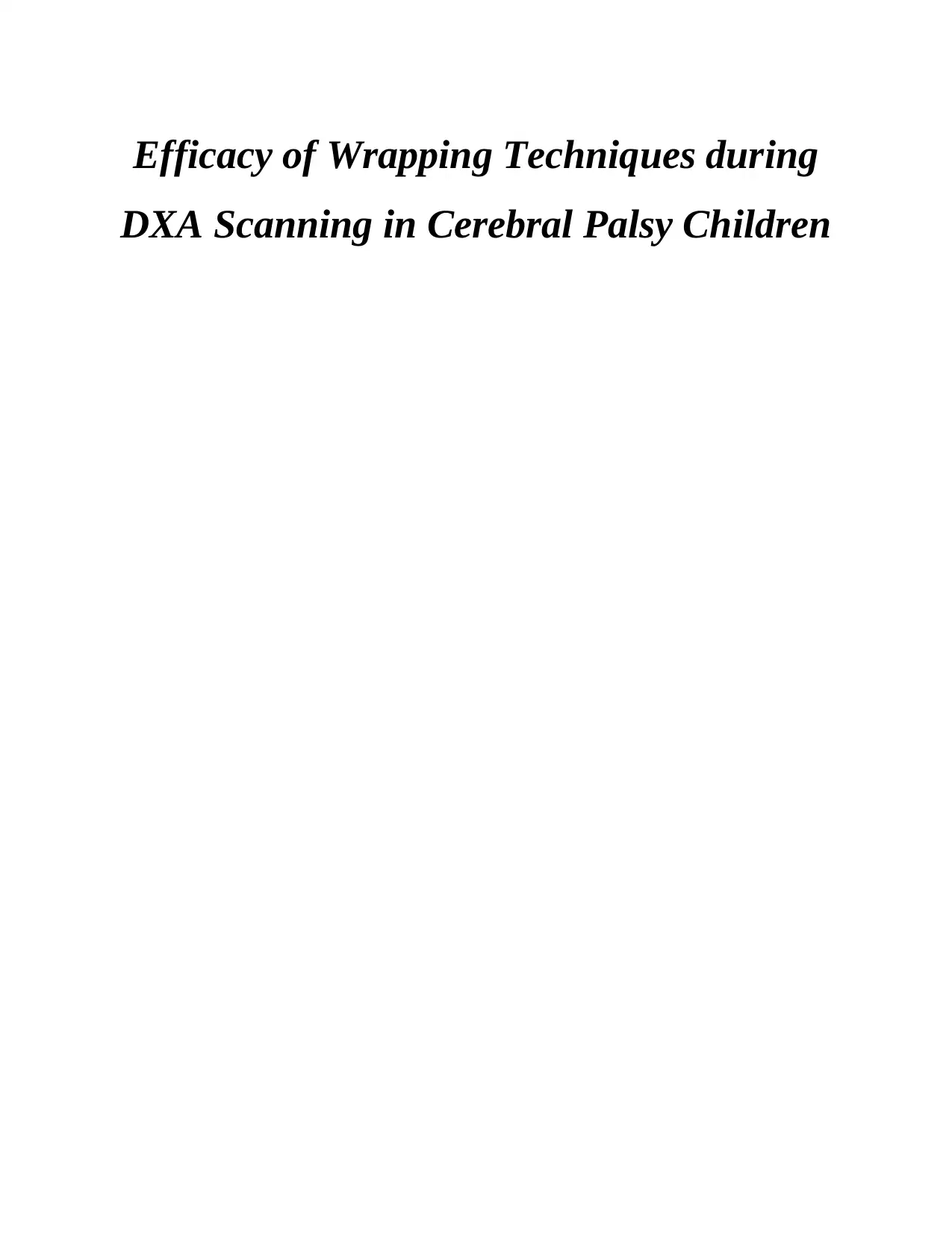
Efficacy of Wrapping Techniques during
DXA Scanning in Cerebral Palsy Children
DXA Scanning in Cerebral Palsy Children
Paraphrase This Document
Need a fresh take? Get an instant paraphrase of this document with our AI Paraphraser

TABLE OF CONTENTS
INTRODUCTION...........................................................................................................................1
REFERENCES................................................................................................................................1
INTRODUCTION...........................................................................................................................1
REFERENCES................................................................................................................................1
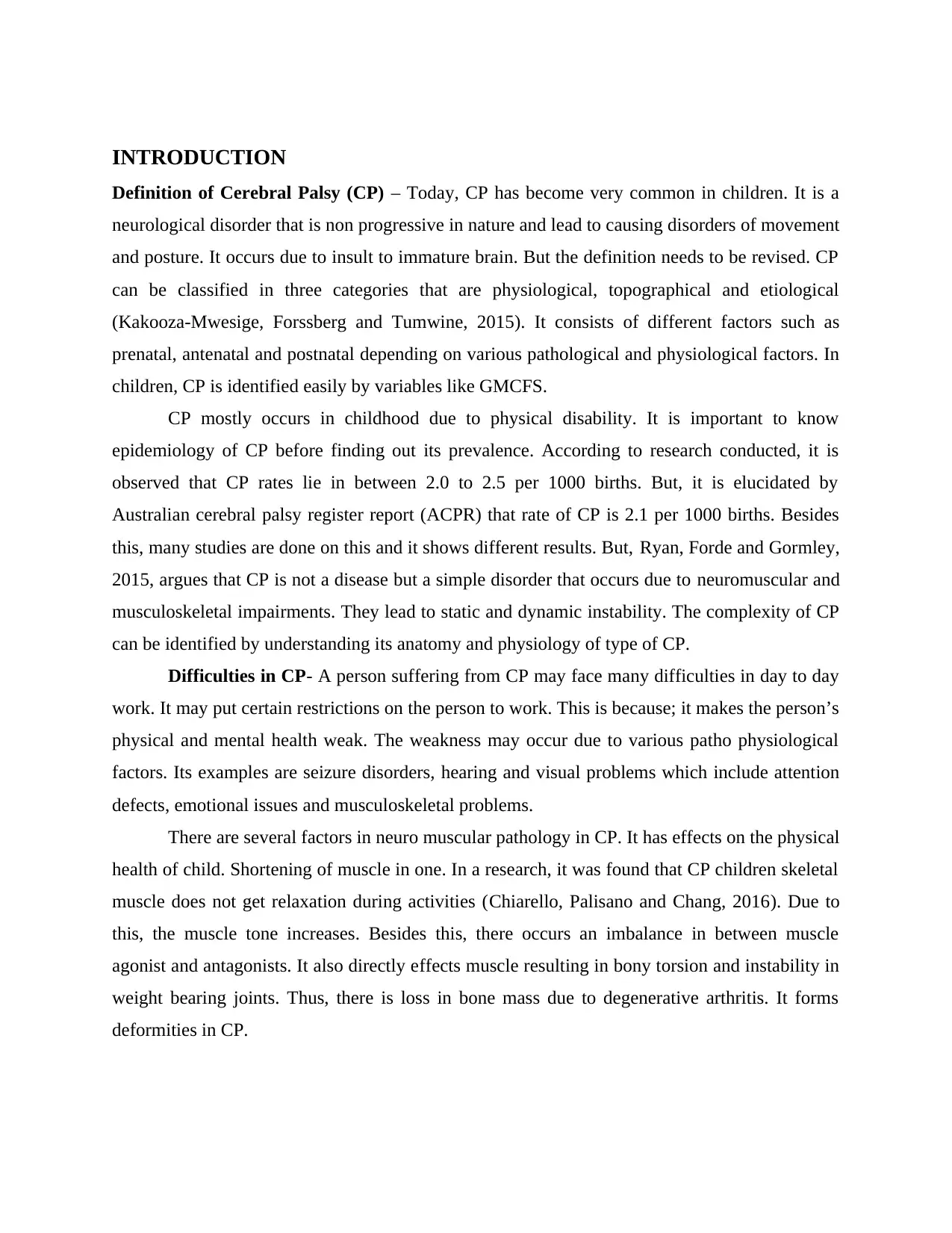
INTRODUCTION
Definition of Cerebral Palsy (CP) – Today, CP has become very common in children. It is a
neurological disorder that is non progressive in nature and lead to causing disorders of movement
and posture. It occurs due to insult to immature brain. But the definition needs to be revised. CP
can be classified in three categories that are physiological, topographical and etiological
(Kakooza-Mwesige, Forssberg and Tumwine, 2015). It consists of different factors such as
prenatal, antenatal and postnatal depending on various pathological and physiological factors. In
children, CP is identified easily by variables like GMCFS.
CP mostly occurs in childhood due to physical disability. It is important to know
epidemiology of CP before finding out its prevalence. According to research conducted, it is
observed that CP rates lie in between 2.0 to 2.5 per 1000 births. But, it is elucidated by
Australian cerebral palsy register report (ACPR) that rate of CP is 2.1 per 1000 births. Besides
this, many studies are done on this and it shows different results. But, Ryan, Forde and Gormley,
2015, argues that CP is not a disease but a simple disorder that occurs due to neuromuscular and
musculoskeletal impairments. They lead to static and dynamic instability. The complexity of CP
can be identified by understanding its anatomy and physiology of type of CP.
Difficulties in CP- A person suffering from CP may face many difficulties in day to day
work. It may put certain restrictions on the person to work. This is because; it makes the person’s
physical and mental health weak. The weakness may occur due to various patho physiological
factors. Its examples are seizure disorders, hearing and visual problems which include attention
defects, emotional issues and musculoskeletal problems.
There are several factors in neuro muscular pathology in CP. It has effects on the physical
health of child. Shortening of muscle in one. In a research, it was found that CP children skeletal
muscle does not get relaxation during activities (Chiarello, Palisano and Chang, 2016). Due to
this, the muscle tone increases. Besides this, there occurs an imbalance in between muscle
agonist and antagonists. It also directly effects muscle resulting in bony torsion and instability in
weight bearing joints. Thus, there is loss in bone mass due to degenerative arthritis. It forms
deformities in CP.
Definition of Cerebral Palsy (CP) – Today, CP has become very common in children. It is a
neurological disorder that is non progressive in nature and lead to causing disorders of movement
and posture. It occurs due to insult to immature brain. But the definition needs to be revised. CP
can be classified in three categories that are physiological, topographical and etiological
(Kakooza-Mwesige, Forssberg and Tumwine, 2015). It consists of different factors such as
prenatal, antenatal and postnatal depending on various pathological and physiological factors. In
children, CP is identified easily by variables like GMCFS.
CP mostly occurs in childhood due to physical disability. It is important to know
epidemiology of CP before finding out its prevalence. According to research conducted, it is
observed that CP rates lie in between 2.0 to 2.5 per 1000 births. But, it is elucidated by
Australian cerebral palsy register report (ACPR) that rate of CP is 2.1 per 1000 births. Besides
this, many studies are done on this and it shows different results. But, Ryan, Forde and Gormley,
2015, argues that CP is not a disease but a simple disorder that occurs due to neuromuscular and
musculoskeletal impairments. They lead to static and dynamic instability. The complexity of CP
can be identified by understanding its anatomy and physiology of type of CP.
Difficulties in CP- A person suffering from CP may face many difficulties in day to day
work. It may put certain restrictions on the person to work. This is because; it makes the person’s
physical and mental health weak. The weakness may occur due to various patho physiological
factors. Its examples are seizure disorders, hearing and visual problems which include attention
defects, emotional issues and musculoskeletal problems.
There are several factors in neuro muscular pathology in CP. It has effects on the physical
health of child. Shortening of muscle in one. In a research, it was found that CP children skeletal
muscle does not get relaxation during activities (Chiarello, Palisano and Chang, 2016). Due to
this, the muscle tone increases. Besides this, there occurs an imbalance in between muscle
agonist and antagonists. It also directly effects muscle resulting in bony torsion and instability in
weight bearing joints. Thus, there is loss in bone mass due to degenerative arthritis. It forms
deformities in CP.
⊘ This is a preview!⊘
Do you want full access?
Subscribe today to unlock all pages.

Trusted by 1+ million students worldwide
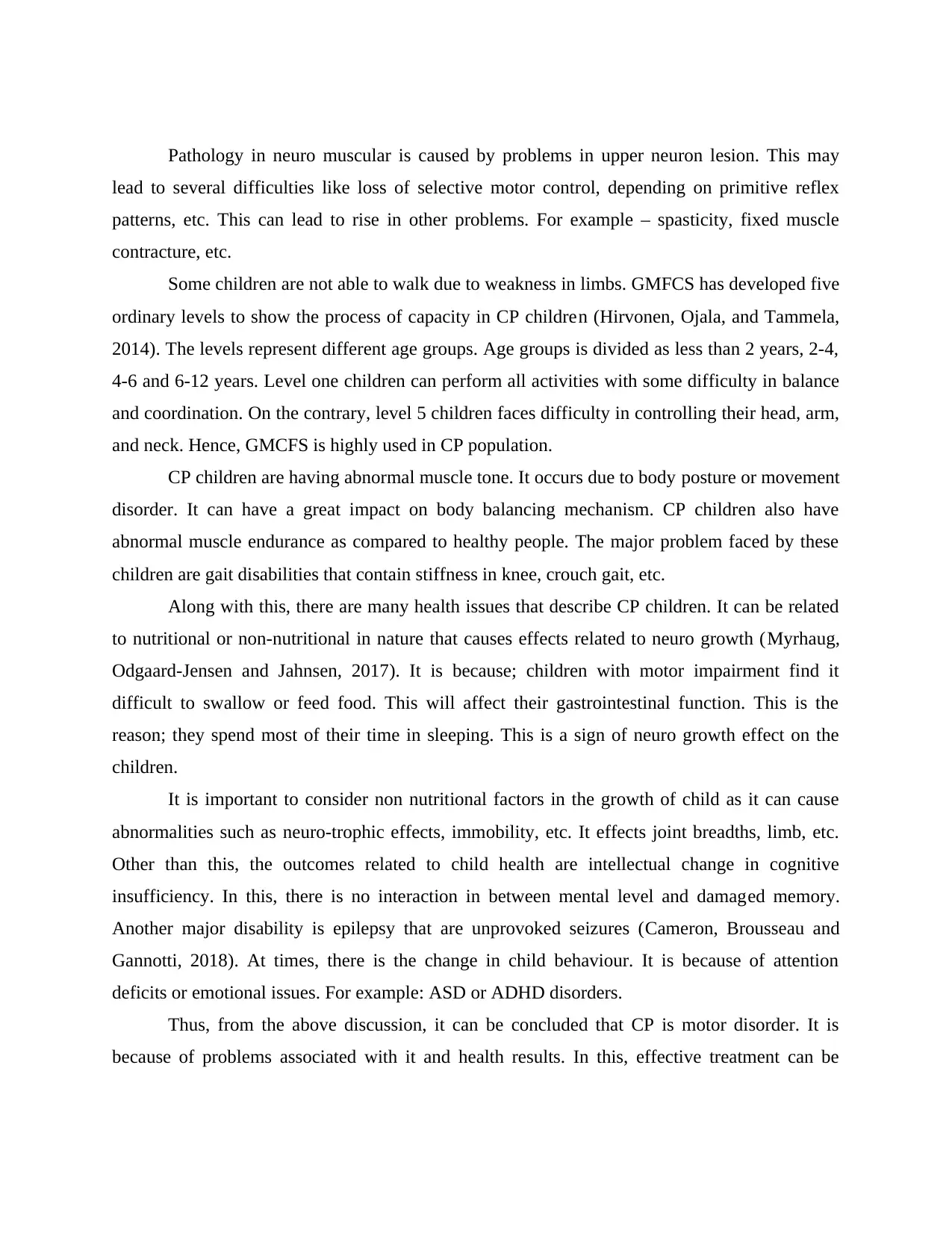
Pathology in neuro muscular is caused by problems in upper neuron lesion. This may
lead to several difficulties like loss of selective motor control, depending on primitive reflex
patterns, etc. This can lead to rise in other problems. For example – spasticity, fixed muscle
contracture, etc.
Some children are not able to walk due to weakness in limbs. GMFCS has developed five
ordinary levels to show the process of capacity in CP children (Hirvonen, Ojala, and Tammela,
2014). The levels represent different age groups. Age groups is divided as less than 2 years, 2-4,
4-6 and 6-12 years. Level one children can perform all activities with some difficulty in balance
and coordination. On the contrary, level 5 children faces difficulty in controlling their head, arm,
and neck. Hence, GMCFS is highly used in CP population.
CP children are having abnormal muscle tone. It occurs due to body posture or movement
disorder. It can have a great impact on body balancing mechanism. CP children also have
abnormal muscle endurance as compared to healthy people. The major problem faced by these
children are gait disabilities that contain stiffness in knee, crouch gait, etc.
Along with this, there are many health issues that describe CP children. It can be related
to nutritional or non-nutritional in nature that causes effects related to neuro growth (Myrhaug,
Odgaard-Jensen and Jahnsen, 2017). It is because; children with motor impairment find it
difficult to swallow or feed food. This will affect their gastrointestinal function. This is the
reason; they spend most of their time in sleeping. This is a sign of neuro growth effect on the
children.
It is important to consider non nutritional factors in the growth of child as it can cause
abnormalities such as neuro-trophic effects, immobility, etc. It effects joint breadths, limb, etc.
Other than this, the outcomes related to child health are intellectual change in cognitive
insufficiency. In this, there is no interaction in between mental level and damaged memory.
Another major disability is epilepsy that are unprovoked seizures (Cameron, Brousseau and
Gannotti, 2018). At times, there is the change in child behaviour. It is because of attention
deficits or emotional issues. For example: ASD or ADHD disorders.
Thus, from the above discussion, it can be concluded that CP is motor disorder. It is
because of problems associated with it and health results. In this, effective treatment can be
lead to several difficulties like loss of selective motor control, depending on primitive reflex
patterns, etc. This can lead to rise in other problems. For example – spasticity, fixed muscle
contracture, etc.
Some children are not able to walk due to weakness in limbs. GMFCS has developed five
ordinary levels to show the process of capacity in CP children (Hirvonen, Ojala, and Tammela,
2014). The levels represent different age groups. Age groups is divided as less than 2 years, 2-4,
4-6 and 6-12 years. Level one children can perform all activities with some difficulty in balance
and coordination. On the contrary, level 5 children faces difficulty in controlling their head, arm,
and neck. Hence, GMCFS is highly used in CP population.
CP children are having abnormal muscle tone. It occurs due to body posture or movement
disorder. It can have a great impact on body balancing mechanism. CP children also have
abnormal muscle endurance as compared to healthy people. The major problem faced by these
children are gait disabilities that contain stiffness in knee, crouch gait, etc.
Along with this, there are many health issues that describe CP children. It can be related
to nutritional or non-nutritional in nature that causes effects related to neuro growth (Myrhaug,
Odgaard-Jensen and Jahnsen, 2017). It is because; children with motor impairment find it
difficult to swallow or feed food. This will affect their gastrointestinal function. This is the
reason; they spend most of their time in sleeping. This is a sign of neuro growth effect on the
children.
It is important to consider non nutritional factors in the growth of child as it can cause
abnormalities such as neuro-trophic effects, immobility, etc. It effects joint breadths, limb, etc.
Other than this, the outcomes related to child health are intellectual change in cognitive
insufficiency. In this, there is no interaction in between mental level and damaged memory.
Another major disability is epilepsy that are unprovoked seizures (Cameron, Brousseau and
Gannotti, 2018). At times, there is the change in child behaviour. It is because of attention
deficits or emotional issues. For example: ASD or ADHD disorders.
Thus, from the above discussion, it can be concluded that CP is motor disorder. It is
because of problems associated with it and health results. In this, effective treatment can be
Paraphrase This Document
Need a fresh take? Get an instant paraphrase of this document with our AI Paraphraser
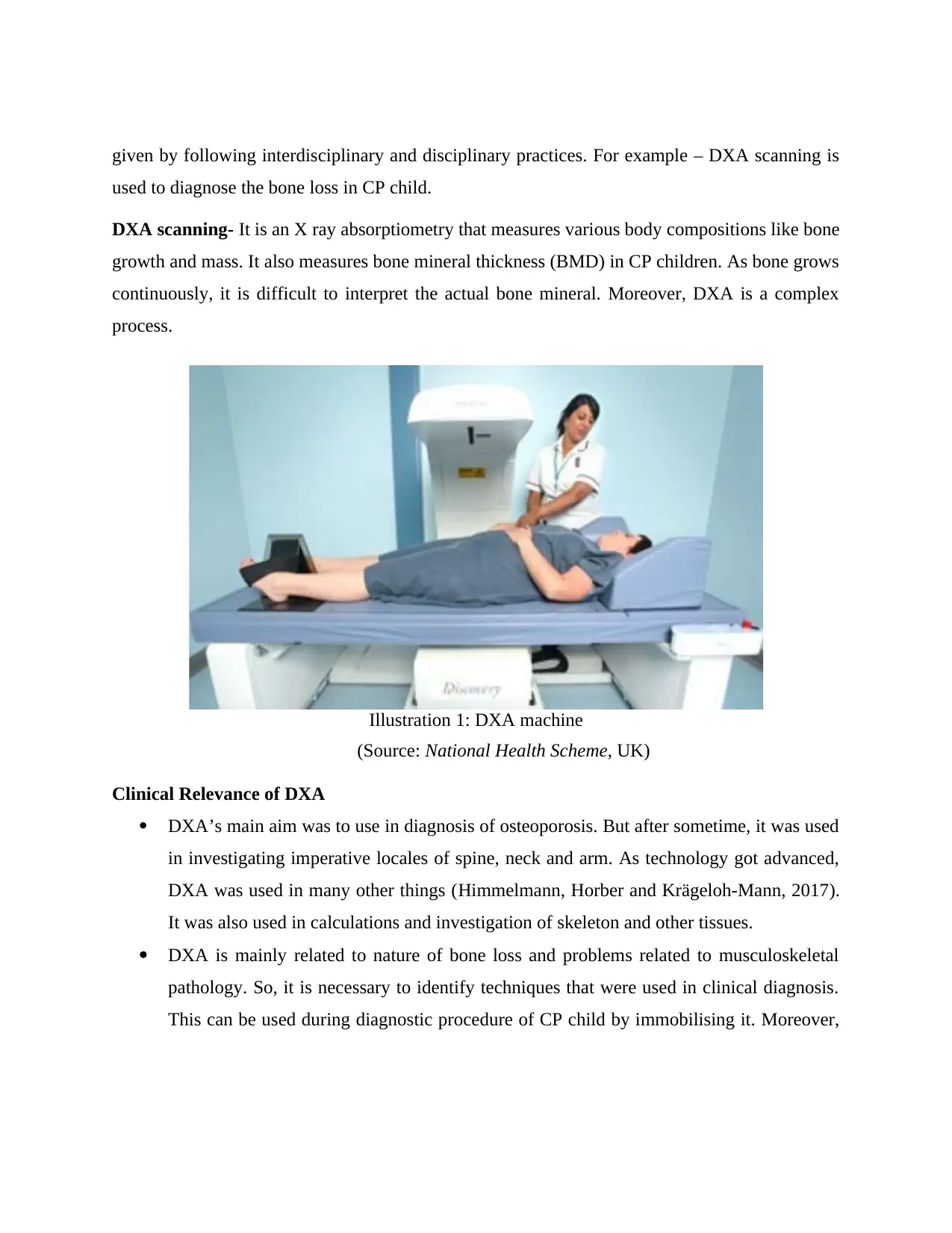
given by following interdisciplinary and disciplinary practices. For example – DXA scanning is
used to diagnose the bone loss in CP child.
DXA scanning- It is an X ray absorptiometry that measures various body compositions like bone
growth and mass. It also measures bone mineral thickness (BMD) in CP children. As bone grows
continuously, it is difficult to interpret the actual bone mineral. Moreover, DXA is a complex
process.
Illustration 1: DXA machine
(Source: National Health Scheme, UK)
Clinical Relevance of DXA
DXA’s main aim was to use in diagnosis of osteoporosis. But after sometime, it was used
in investigating imperative locales of spine, neck and arm. As technology got advanced,
DXA was used in many other things (Himmelmann, Horber and Krägeloh‐Mann, 2017).
It was also used in calculations and investigation of skeleton and other tissues.
DXA is mainly related to nature of bone loss and problems related to musculoskeletal
pathology. So, it is necessary to identify techniques that were used in clinical diagnosis.
This can be used during diagnostic procedure of CP child by immobilising it. Moreover,
used to diagnose the bone loss in CP child.
DXA scanning- It is an X ray absorptiometry that measures various body compositions like bone
growth and mass. It also measures bone mineral thickness (BMD) in CP children. As bone grows
continuously, it is difficult to interpret the actual bone mineral. Moreover, DXA is a complex
process.
Illustration 1: DXA machine
(Source: National Health Scheme, UK)
Clinical Relevance of DXA
DXA’s main aim was to use in diagnosis of osteoporosis. But after sometime, it was used
in investigating imperative locales of spine, neck and arm. As technology got advanced,
DXA was used in many other things (Himmelmann, Horber and Krägeloh‐Mann, 2017).
It was also used in calculations and investigation of skeleton and other tissues.
DXA is mainly related to nature of bone loss and problems related to musculoskeletal
pathology. So, it is necessary to identify techniques that were used in clinical diagnosis.
This can be used during diagnostic procedure of CP child by immobilising it. Moreover,
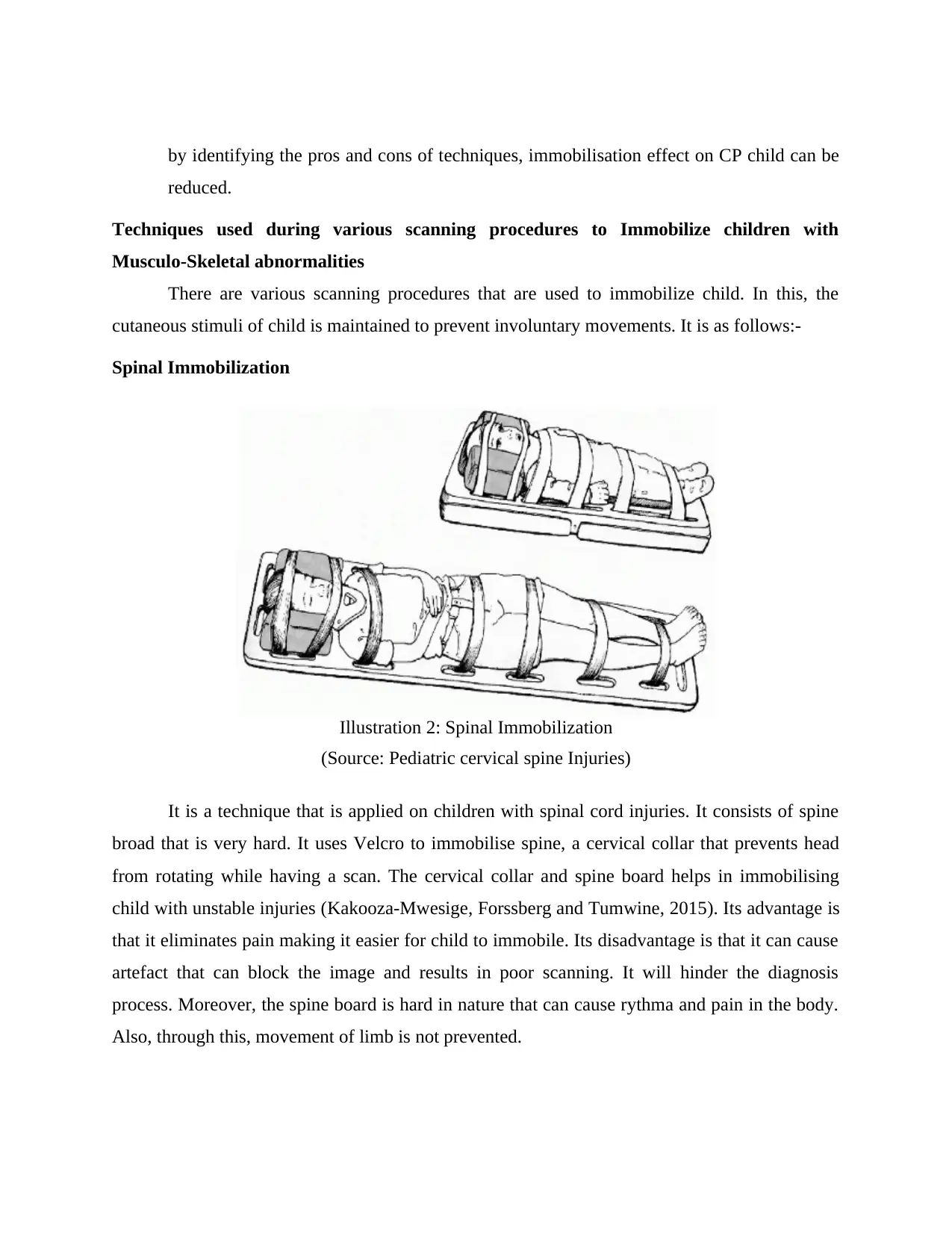
by identifying the pros and cons of techniques, immobilisation effect on CP child can be
reduced.
Techniques used during various scanning procedures to Immobilize children with
Musculo-Skeletal abnormalities
There are various scanning procedures that are used to immobilize child. In this, the
cutaneous stimuli of child is maintained to prevent involuntary movements. It is as follows:-
Spinal Immobilization
Illustration 2: Spinal Immobilization
(Source: Pediatric cervical spine Injuries)
It is a technique that is applied on children with spinal cord injuries. It consists of spine
broad that is very hard. It uses Velcro to immobilise spine, a cervical collar that prevents head
from rotating while having a scan. The cervical collar and spine board helps in immobilising
child with unstable injuries (Kakooza-Mwesige, Forssberg and Tumwine, 2015). Its advantage is
that it eliminates pain making it easier for child to immobile. Its disadvantage is that it can cause
artefact that can block the image and results in poor scanning. It will hinder the diagnosis
process. Moreover, the spine board is hard in nature that can cause rythma and pain in the body.
Also, through this, movement of limb is not prevented.
reduced.
Techniques used during various scanning procedures to Immobilize children with
Musculo-Skeletal abnormalities
There are various scanning procedures that are used to immobilize child. In this, the
cutaneous stimuli of child is maintained to prevent involuntary movements. It is as follows:-
Spinal Immobilization
Illustration 2: Spinal Immobilization
(Source: Pediatric cervical spine Injuries)
It is a technique that is applied on children with spinal cord injuries. It consists of spine
broad that is very hard. It uses Velcro to immobilise spine, a cervical collar that prevents head
from rotating while having a scan. The cervical collar and spine board helps in immobilising
child with unstable injuries (Kakooza-Mwesige, Forssberg and Tumwine, 2015). Its advantage is
that it eliminates pain making it easier for child to immobile. Its disadvantage is that it can cause
artefact that can block the image and results in poor scanning. It will hinder the diagnosis
process. Moreover, the spine board is hard in nature that can cause rythma and pain in the body.
Also, through this, movement of limb is not prevented.
⊘ This is a preview!⊘
Do you want full access?
Subscribe today to unlock all pages.

Trusted by 1+ million students worldwide
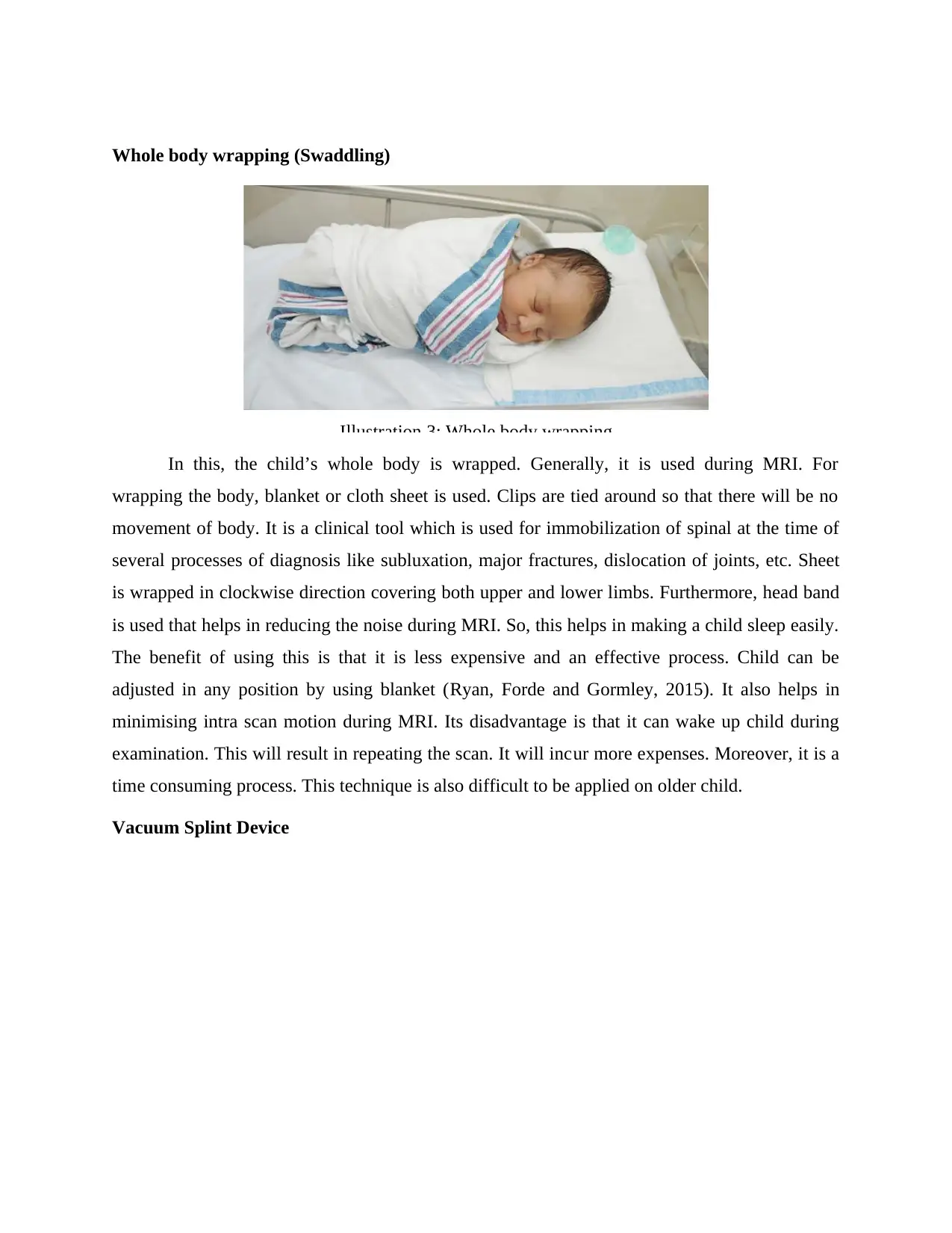
Whole body wrapping (Swaddling)
Illustration 3: Whole body wrapping
In this, the child’s whole body is wrapped. Generally, it is used during MRI. For
wrapping the body, blanket or cloth sheet is used. Clips are tied around so that there will be no
movement of body. It is a clinical tool which is used for immobilization of spinal at the time of
several processes of diagnosis like subluxation, major fractures, dislocation of joints, etc. Sheet
is wrapped in clockwise direction covering both upper and lower limbs. Furthermore, head band
is used that helps in reducing the noise during MRI. So, this helps in making a child sleep easily.
The benefit of using this is that it is less expensive and an effective process. Child can be
adjusted in any position by using blanket (Ryan, Forde and Gormley, 2015). It also helps in
minimising intra scan motion during MRI. Its disadvantage is that it can wake up child during
examination. This will result in repeating the scan. It will incur more expenses. Moreover, it is a
time consuming process. This technique is also difficult to be applied on older child.
Vacuum Splint Device
Illustration 3: Whole body wrapping
In this, the child’s whole body is wrapped. Generally, it is used during MRI. For
wrapping the body, blanket or cloth sheet is used. Clips are tied around so that there will be no
movement of body. It is a clinical tool which is used for immobilization of spinal at the time of
several processes of diagnosis like subluxation, major fractures, dislocation of joints, etc. Sheet
is wrapped in clockwise direction covering both upper and lower limbs. Furthermore, head band
is used that helps in reducing the noise during MRI. So, this helps in making a child sleep easily.
The benefit of using this is that it is less expensive and an effective process. Child can be
adjusted in any position by using blanket (Ryan, Forde and Gormley, 2015). It also helps in
minimising intra scan motion during MRI. Its disadvantage is that it can wake up child during
examination. This will result in repeating the scan. It will incur more expenses. Moreover, it is a
time consuming process. This technique is also difficult to be applied on older child.
Vacuum Splint Device
Paraphrase This Document
Need a fresh take? Get an instant paraphrase of this document with our AI Paraphraser
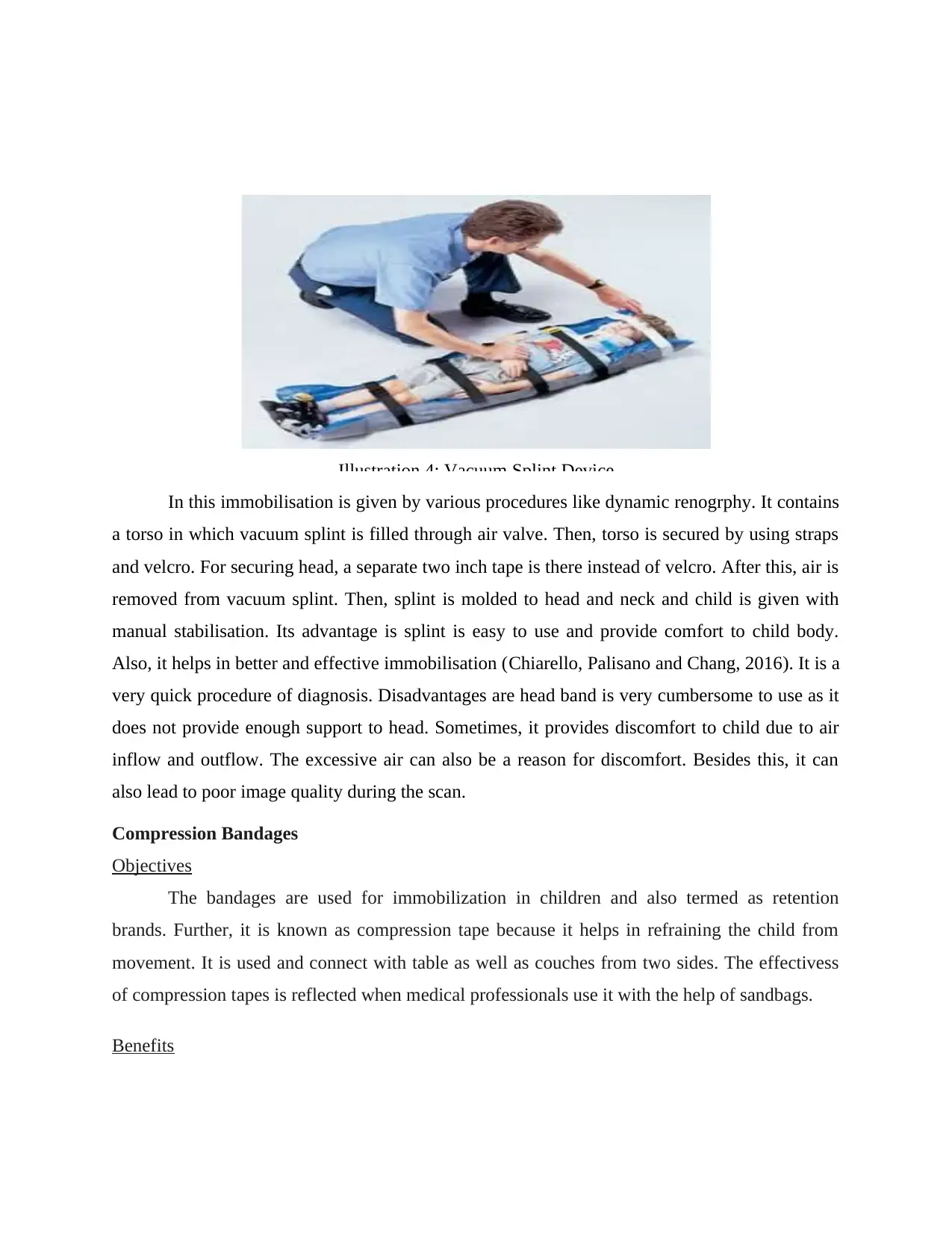
Illustration 4: Vacuum Splint Device
In this immobilisation is given by various procedures like dynamic renogrphy. It contains
a torso in which vacuum splint is filled through air valve. Then, torso is secured by using straps
and velcro. For securing head, a separate two inch tape is there instead of velcro. After this, air is
removed from vacuum splint. Then, splint is molded to head and neck and child is given with
manual stabilisation. Its advantage is splint is easy to use and provide comfort to child body.
Also, it helps in better and effective immobilisation (Chiarello, Palisano and Chang, 2016). It is a
very quick procedure of diagnosis. Disadvantages are head band is very cumbersome to use as it
does not provide enough support to head. Sometimes, it provides discomfort to child due to air
inflow and outflow. The excessive air can also be a reason for discomfort. Besides this, it can
also lead to poor image quality during the scan.
Compression Bandages
Objectives
The bandages are used for immobilization in children and also termed as retention
brands. Further, it is known as compression tape because it helps in refraining the child from
movement. It is used and connect with table as well as couches from two sides. The effectivess
of compression tapes is reflected when medical professionals use it with the help of sandbags.
Benefits
In this immobilisation is given by various procedures like dynamic renogrphy. It contains
a torso in which vacuum splint is filled through air valve. Then, torso is secured by using straps
and velcro. For securing head, a separate two inch tape is there instead of velcro. After this, air is
removed from vacuum splint. Then, splint is molded to head and neck and child is given with
manual stabilisation. Its advantage is splint is easy to use and provide comfort to child body.
Also, it helps in better and effective immobilisation (Chiarello, Palisano and Chang, 2016). It is a
very quick procedure of diagnosis. Disadvantages are head band is very cumbersome to use as it
does not provide enough support to head. Sometimes, it provides discomfort to child due to air
inflow and outflow. The excessive air can also be a reason for discomfort. Besides this, it can
also lead to poor image quality during the scan.
Compression Bandages
Objectives
The bandages are used for immobilization in children and also termed as retention
brands. Further, it is known as compression tape because it helps in refraining the child from
movement. It is used and connect with table as well as couches from two sides. The effectivess
of compression tapes is reflected when medical professionals use it with the help of sandbags.
Benefits
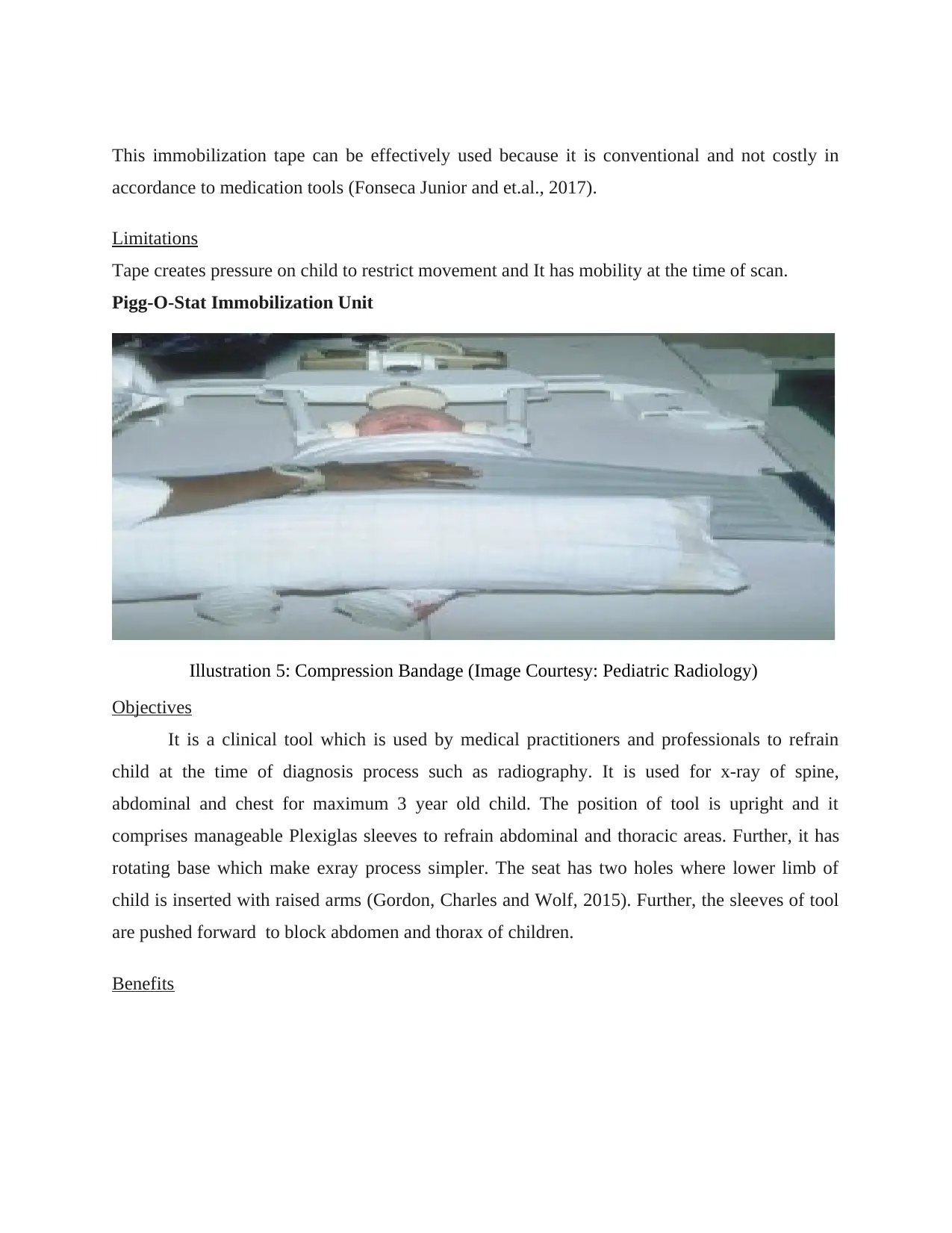
This immobilization tape can be effectively used because it is conventional and not costly in
accordance to medication tools (Fonseca Junior and et.al., 2017).
Limitations
Tape creates pressure on child to restrict movement and It has mobility at the time of scan.
Pigg-O-Stat Immobilization Unit
Illustration 5: Compression Bandage (Image Courtesy: Pediatric Radiology)
Objectives
It is a clinical tool which is used by medical practitioners and professionals to refrain
child at the time of diagnosis process such as radiography. It is used for x-ray of spine,
abdominal and chest for maximum 3 year old child. The position of tool is upright and it
comprises manageable Plexiglas sleeves to refrain abdominal and thoracic areas. Further, it has
rotating base which make exray process simpler. The seat has two holes where lower limb of
child is inserted with raised arms (Gordon, Charles and Wolf, 2015). Further, the sleeves of tool
are pushed forward to block abdomen and thorax of children.
Benefits
accordance to medication tools (Fonseca Junior and et.al., 2017).
Limitations
Tape creates pressure on child to restrict movement and It has mobility at the time of scan.
Pigg-O-Stat Immobilization Unit
Illustration 5: Compression Bandage (Image Courtesy: Pediatric Radiology)
Objectives
It is a clinical tool which is used by medical practitioners and professionals to refrain
child at the time of diagnosis process such as radiography. It is used for x-ray of spine,
abdominal and chest for maximum 3 year old child. The position of tool is upright and it
comprises manageable Plexiglas sleeves to refrain abdominal and thoracic areas. Further, it has
rotating base which make exray process simpler. The seat has two holes where lower limb of
child is inserted with raised arms (Gordon, Charles and Wolf, 2015). Further, the sleeves of tool
are pushed forward to block abdomen and thorax of children.
Benefits
⊘ This is a preview!⊘
Do you want full access?
Subscribe today to unlock all pages.

Trusted by 1+ million students worldwide
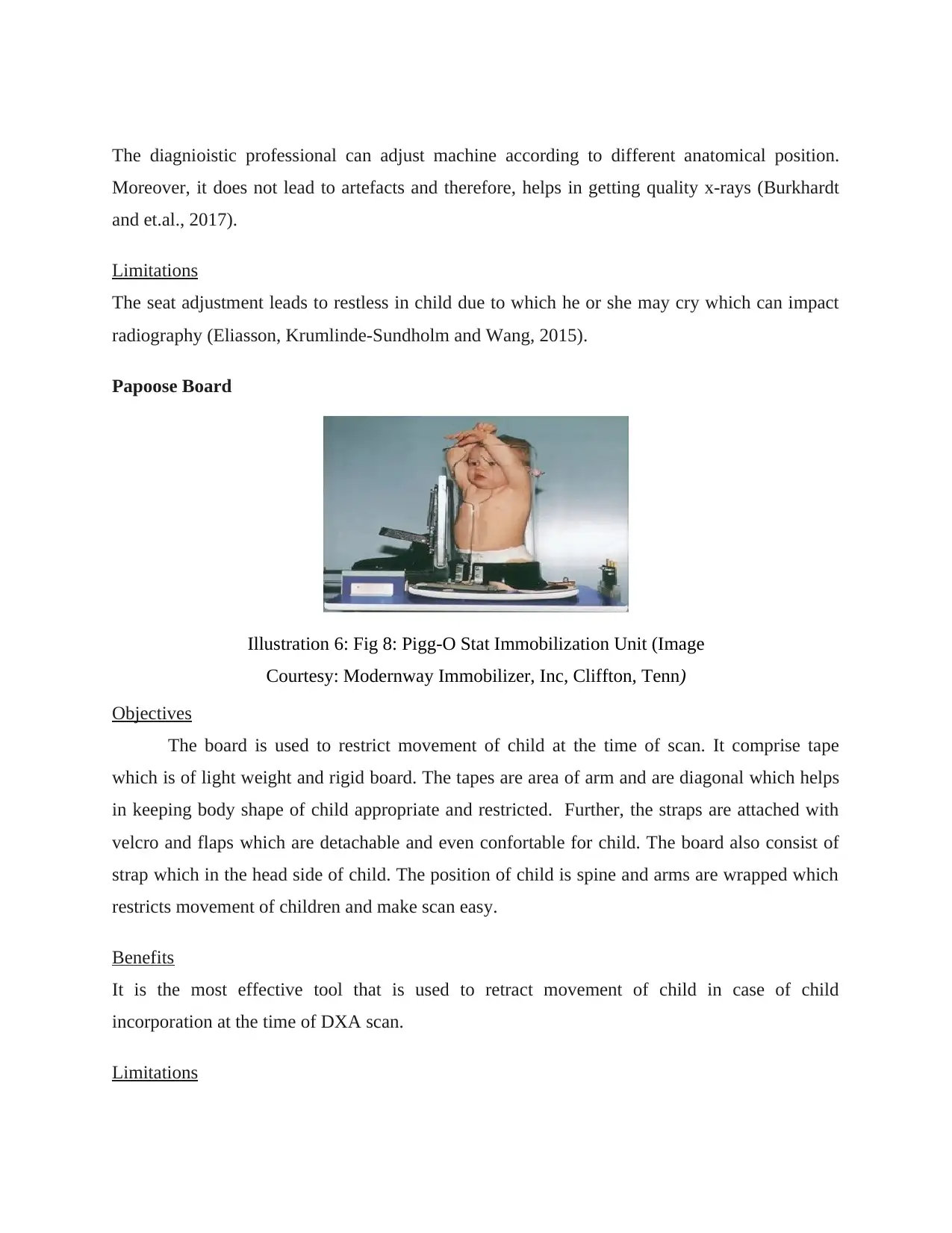
The diagnioistic professional can adjust machine according to different anatomical position.
Moreover, it does not lead to artefacts and therefore, helps in getting quality x-rays (Burkhardt
and et.al., 2017).
Limitations
The seat adjustment leads to restless in child due to which he or she may cry which can impact
radiography (Eliasson, Krumlinde-Sundholm and Wang, 2015).
Papoose Board
Illustration 6: Fig 8: Pigg-O Stat Immobilization Unit (Image
Courtesy: Modernway Immobilizer, Inc, Cliffton, Tenn)
Objectives
The board is used to restrict movement of child at the time of scan. It comprise tape
which is of light weight and rigid board. The tapes are area of arm and are diagonal which helps
in keeping body shape of child appropriate and restricted. Further, the straps are attached with
velcro and flaps which are detachable and even confortable for child. The board also consist of
strap which in the head side of child. The position of child is spine and arms are wrapped which
restricts movement of children and make scan easy.
Benefits
It is the most effective tool that is used to retract movement of child in case of child
incorporation at the time of DXA scan.
Limitations
Moreover, it does not lead to artefacts and therefore, helps in getting quality x-rays (Burkhardt
and et.al., 2017).
Limitations
The seat adjustment leads to restless in child due to which he or she may cry which can impact
radiography (Eliasson, Krumlinde-Sundholm and Wang, 2015).
Papoose Board
Illustration 6: Fig 8: Pigg-O Stat Immobilization Unit (Image
Courtesy: Modernway Immobilizer, Inc, Cliffton, Tenn)
Objectives
The board is used to restrict movement of child at the time of scan. It comprise tape
which is of light weight and rigid board. The tapes are area of arm and are diagonal which helps
in keeping body shape of child appropriate and restricted. Further, the straps are attached with
velcro and flaps which are detachable and even confortable for child. The board also consist of
strap which in the head side of child. The position of child is spine and arms are wrapped which
restricts movement of children and make scan easy.
Benefits
It is the most effective tool that is used to retract movement of child in case of child
incorporation at the time of DXA scan.
Limitations
Paraphrase This Document
Need a fresh take? Get an instant paraphrase of this document with our AI Paraphraser
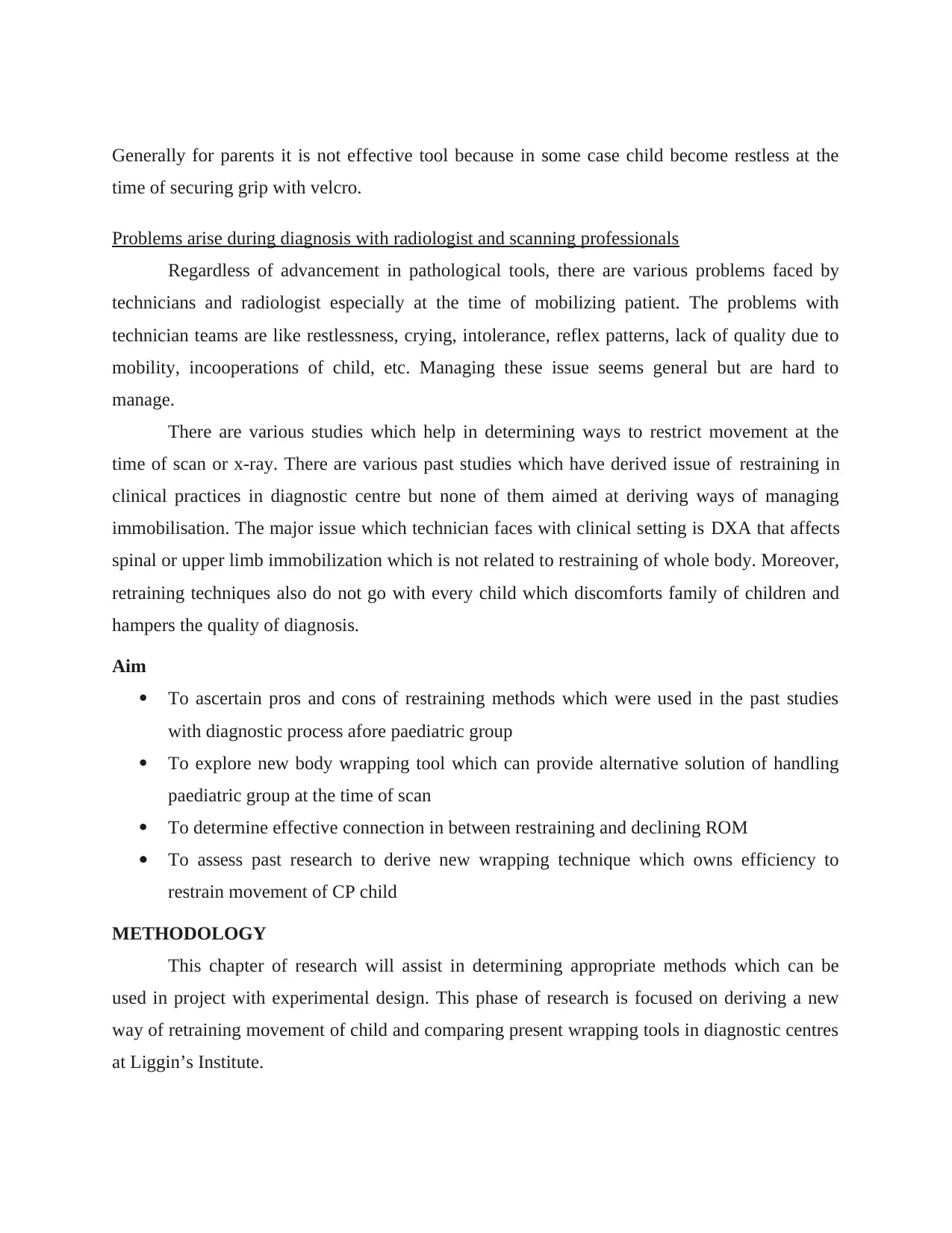
Generally for parents it is not effective tool because in some case child become restless at the
time of securing grip with velcro.
Problems arise during diagnosis with radiologist and scanning professionals
Regardless of advancement in pathological tools, there are various problems faced by
technicians and radiologist especially at the time of mobilizing patient. The problems with
technician teams are like restlessness, crying, intolerance, reflex patterns, lack of quality due to
mobility, incooperations of child, etc. Managing these issue seems general but are hard to
manage.
There are various studies which help in determining ways to restrict movement at the
time of scan or x-ray. There are various past studies which have derived issue of restraining in
clinical practices in diagnostic centre but none of them aimed at deriving ways of managing
immobilisation. The major issue which technician faces with clinical setting is DXA that affects
spinal or upper limb immobilization which is not related to restraining of whole body. Moreover,
retraining techniques also do not go with every child which discomforts family of children and
hampers the quality of diagnosis.
Aim
To ascertain pros and cons of restraining methods which were used in the past studies
with diagnostic process afore paediatric group
To explore new body wrapping tool which can provide alternative solution of handling
paediatric group at the time of scan
To determine effective connection in between restraining and declining ROM
To assess past research to derive new wrapping technique which owns efficiency to
restrain movement of CP child
METHODOLOGY
This chapter of research will assist in determining appropriate methods which can be
used in project with experimental design. This phase of research is focused on deriving a new
way of retraining movement of child and comparing present wrapping tools in diagnostic centres
at Liggin’s Institute.
time of securing grip with velcro.
Problems arise during diagnosis with radiologist and scanning professionals
Regardless of advancement in pathological tools, there are various problems faced by
technicians and radiologist especially at the time of mobilizing patient. The problems with
technician teams are like restlessness, crying, intolerance, reflex patterns, lack of quality due to
mobility, incooperations of child, etc. Managing these issue seems general but are hard to
manage.
There are various studies which help in determining ways to restrict movement at the
time of scan or x-ray. There are various past studies which have derived issue of restraining in
clinical practices in diagnostic centre but none of them aimed at deriving ways of managing
immobilisation. The major issue which technician faces with clinical setting is DXA that affects
spinal or upper limb immobilization which is not related to restraining of whole body. Moreover,
retraining techniques also do not go with every child which discomforts family of children and
hampers the quality of diagnosis.
Aim
To ascertain pros and cons of restraining methods which were used in the past studies
with diagnostic process afore paediatric group
To explore new body wrapping tool which can provide alternative solution of handling
paediatric group at the time of scan
To determine effective connection in between restraining and declining ROM
To assess past research to derive new wrapping technique which owns efficiency to
restrain movement of CP child
METHODOLOGY
This chapter of research will assist in determining appropriate methods which can be
used in project with experimental design. This phase of research is focused on deriving a new
way of retraining movement of child and comparing present wrapping tools in diagnostic centres
at Liggin’s Institute.
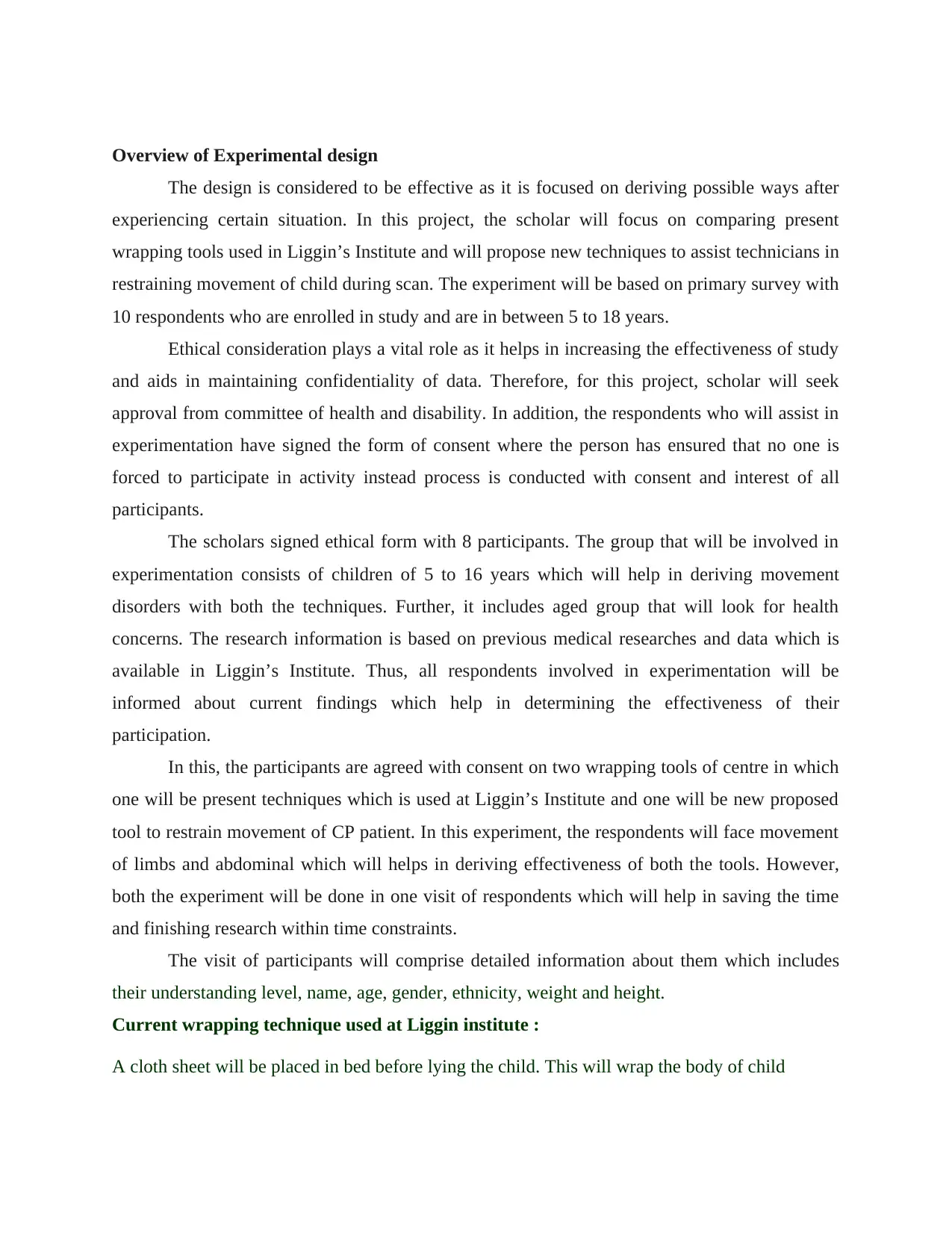
Overview of Experimental design
The design is considered to be effective as it is focused on deriving possible ways after
experiencing certain situation. In this project, the scholar will focus on comparing present
wrapping tools used in Liggin’s Institute and will propose new techniques to assist technicians in
restraining movement of child during scan. The experiment will be based on primary survey with
10 respondents who are enrolled in study and are in between 5 to 18 years.
Ethical consideration plays a vital role as it helps in increasing the effectiveness of study
and aids in maintaining confidentiality of data. Therefore, for this project, scholar will seek
approval from committee of health and disability. In addition, the respondents who will assist in
experimentation have signed the form of consent where the person has ensured that no one is
forced to participate in activity instead process is conducted with consent and interest of all
participants.
The scholars signed ethical form with 8 participants. The group that will be involved in
experimentation consists of children of 5 to 16 years which will help in deriving movement
disorders with both the techniques. Further, it includes aged group that will look for health
concerns. The research information is based on previous medical researches and data which is
available in Liggin’s Institute. Thus, all respondents involved in experimentation will be
informed about current findings which help in determining the effectiveness of their
participation.
In this, the participants are agreed with consent on two wrapping tools of centre in which
one will be present techniques which is used at Liggin’s Institute and one will be new proposed
tool to restrain movement of CP patient. In this experiment, the respondents will face movement
of limbs and abdominal which will helps in deriving effectiveness of both the tools. However,
both the experiment will be done in one visit of respondents which will help in saving the time
and finishing research within time constraints.
The visit of participants will comprise detailed information about them which includes
their understanding level, name, age, gender, ethnicity, weight and height.
Current wrapping technique used at Liggin institute :
A cloth sheet will be placed in bed before lying the child. This will wrap the body of child
The design is considered to be effective as it is focused on deriving possible ways after
experiencing certain situation. In this project, the scholar will focus on comparing present
wrapping tools used in Liggin’s Institute and will propose new techniques to assist technicians in
restraining movement of child during scan. The experiment will be based on primary survey with
10 respondents who are enrolled in study and are in between 5 to 18 years.
Ethical consideration plays a vital role as it helps in increasing the effectiveness of study
and aids in maintaining confidentiality of data. Therefore, for this project, scholar will seek
approval from committee of health and disability. In addition, the respondents who will assist in
experimentation have signed the form of consent where the person has ensured that no one is
forced to participate in activity instead process is conducted with consent and interest of all
participants.
The scholars signed ethical form with 8 participants. The group that will be involved in
experimentation consists of children of 5 to 16 years which will help in deriving movement
disorders with both the techniques. Further, it includes aged group that will look for health
concerns. The research information is based on previous medical researches and data which is
available in Liggin’s Institute. Thus, all respondents involved in experimentation will be
informed about current findings which help in determining the effectiveness of their
participation.
In this, the participants are agreed with consent on two wrapping tools of centre in which
one will be present techniques which is used at Liggin’s Institute and one will be new proposed
tool to restrain movement of CP patient. In this experiment, the respondents will face movement
of limbs and abdominal which will helps in deriving effectiveness of both the tools. However,
both the experiment will be done in one visit of respondents which will help in saving the time
and finishing research within time constraints.
The visit of participants will comprise detailed information about them which includes
their understanding level, name, age, gender, ethnicity, weight and height.
Current wrapping technique used at Liggin institute :
A cloth sheet will be placed in bed before lying the child. This will wrap the body of child
⊘ This is a preview!⊘
Do you want full access?
Subscribe today to unlock all pages.

Trusted by 1+ million students worldwide
1 out of 14
Your All-in-One AI-Powered Toolkit for Academic Success.
+13062052269
info@desklib.com
Available 24*7 on WhatsApp / Email
![[object Object]](/_next/static/media/star-bottom.7253800d.svg)
Unlock your academic potential
Copyright © 2020–2025 A2Z Services. All Rights Reserved. Developed and managed by ZUCOL.

